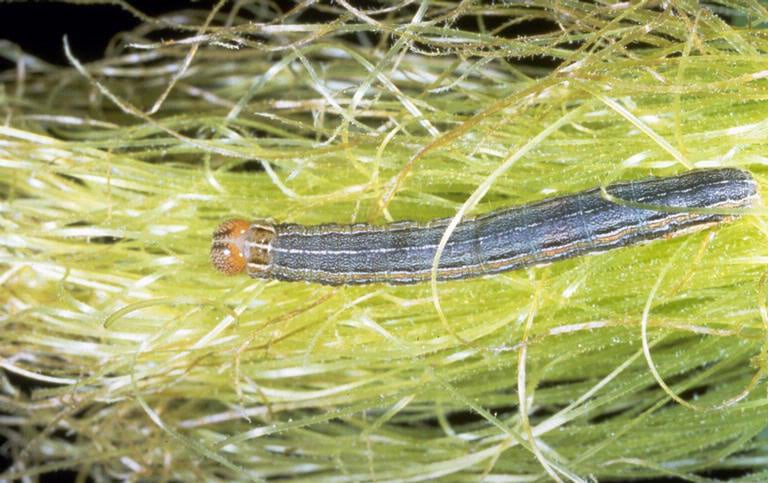
4 Common Lawn Pests in Indiana and How to Get Rid of Them

If there’s one thing that can ruin a beautiful yard faster than a bad haircut ruins picture day – it’s lawn pests. These little critters are out here treating your grass like an all-you-can-eat buffet, and it’s time to put a stop to it. The most common grass-eating insects we see in Indiana are:
Bluegrass Billbug
White Grubs
Sod Webworms
Armyworms
Let’s explore these four common lawn pests in Indiana and how to get rid of them for good.
Bluegrass Billbug
Billbugs are such a problem here in Indiana that we wrote an entire blog about them. You can check it out here. But let’s cover just the highlights.
These little guys are stout, dark-colored weevils about ¼ inch long. You can recognize them by their long snouts – think of them as the elephants of the lawn pest world, except way less cute and way more destructive. Their antennae are attached at the base of that snout, which makes them easy to identify if you ever feel like getting up close and personal. Billbugs don’t just show up one day and start snacking. They’re in it for the long haul. The adults overwinter in protected spots like soil or leaf litter, and when spring rolls around, the females lay their eggs inside grass stems and above-ground shoots. What hatches from those eggs? Legless, white larvae – tiny little lawn-munching nightmares. They start by feeding inside the stems, but as they grow, they move down to the crown and roots, where they can do some serious damage.
Billbugs don’t just show up one day and start snacking. They’re in it for the long haul. The adults overwinter in protected spots like soil or leaf litter, and when spring rolls around, the females lay their eggs inside grass stems and above-ground shoots. What hatches from those eggs? Legless, white larvae – tiny little lawn-munching nightmares. They start by feeding inside the stems, but as they grow, they move down to the crown and roots, where they can do some serious damage.
So, how do you know if you’ve got a billbug problem?
At first, you’ll see individual dead plants, making your turf look a little patchy. Then, as they feast away, those patches get bigger, and before you know it, you’ve got whole sections of grass that break away from the soil. This is especially common in newly sodded lawns, where the roots aren’t well-established yet.
Want to play detective? Keep an eye on sidewalks, driveways, and curbs. Billbug adults love using these flat surfaces as highways to get around. If you suspect damage, try the tug test – just grab a section of damaged grass and pull it. If it comes up easily, you may have billbugs.
White Grubs
If billbugs are the elephants of the lawn pest world, white grubs are the little gremlins burrowing beneath your feet, secretly wreaking havoc. These guys are among the most damaging turf pests in Indiana, and they’re not picky – they’ll take down just about any grass type they can sink their tiny mandibles into. White grubs are the larval stage of several beetle species, including Japanese beetles, chafers, May or June beetles, or black turf grass ataenius. These little C-shaped troublemakers are robust, white, and have a ton of wrinkles along their bodies. They range from ¼ to 1 ½ inches long and have chestnut-colored, hardened head capsules and six legs. Their abdomens tend to be a bit larger and can look darker because they are full of dirt.
White grubs are the larval stage of several beetle species, including Japanese beetles, chafers, May or June beetles, or black turf grass ataenius. These little C-shaped troublemakers are robust, white, and have a ton of wrinkles along their bodies. They range from ¼ to 1 ½ inches long and have chestnut-colored, hardened head capsules and six legs. Their abdomens tend to be a bit larger and can look darker because they are full of dirt.
So, how do you know if you have white grubs?
At first, you might notice your grass looking a little wilted or discolored. That’s just the beginning. As the grubs continue feasting on the root system, your lawn starts collapsing into irregular dead patches, kind of like a really bad game of Tetris. This damage usually shows up in late summer or fall but can also be spotted in the spring.
One giveaway? Your turf peels back easily like cheap carpet when you pull on it, exposing a grub rave underneath. Another telltale sign is if raccoons, skunks, or flocks of birds start treating your lawn like lunch.
Minor grub damage can sometimes be masked with extra irrigation, but once the infestation gets severe, insecticide treatments won’t always save the turf. If you do go the treatment route, keep in mind that grub control products typically need to be watered-in shortly after application to work effectively. At the end of the day, the most effective treatment for white grubs is preventative care.
Sod Webworms
Sod webworms might not have the most intimidating name, but don’t let that fool you – these little guys can do some serious damage to a lawn. Indiana has at least three different species of them, all of which can turn a lush, green lawn into a patchy mess. The adult sod webworm moths are buff-colored, with a wingspan of up to an inch. When they’re at rest, their wings wrap around their bodies, giving them a tubular appearance. They also have a distinctive snout and like to hang out head-down among the blades of grass.
The adult sod webworm moths are buff-colored, with a wingspan of up to an inch. When they’re at rest, their wings wrap around their bodies, giving them a tubular appearance. They also have a distinctive snout and like to hang out head-down among the blades of grass.
The real troublemakers, though, are the larvae. They overwinter in your lawn and start feeding in the spring. By early June, the newly emerged moths are laying eggs, kicking off two or three generations per year. The larvae grow to about an inch long, are tan or dusky green, and have dark spots all over their bodies. These little guys hide out in silk-lined tunnels within the thatch and love feasting on leaf blades and stems.
So, how do you know if you have sod webworms?
You might start noticing thinned-out turf and brown patches where they have been snacking. The good news? Most lawns can bounce back from moderate sod webworm damage. But, if you’re suspicious, there’s a simple test: mix a tablespoon of dishwashing detergent into a gallon of water and pour it over a suspected area. This will flush the larvae out from their hidey-holes so you can confirm their presence. How to get rid of lawn bugs like sod webworms? The best defense against sod webworms is a healthy, well-maintained lawn. If they get out of control, insecticide can help, but timing is key – treat the leaf blades and stems where the larvae feed, and avoid applying right before rain or irrigating for 24 hours after application.
How to get rid of lawn bugs like sod webworms? The best defense against sod webworms is a healthy, well-maintained lawn. If they get out of control, insecticide can help, but timing is key – treat the leaf blades and stems where the larvae feed, and avoid applying right before rain or irrigating for 24 hours after application.
Armyworms
 Armyworms might sound like something out of a sci-fi movie, but these little lawn invaders are all too real. The adult armyworm is a tan to reddish-brown moth, about an inch long, with a wingspan of 1 ½ inches. If you look closely, you’ll notice a tiny white dot in the center of each forewing – that’s their signature look.
Armyworms might sound like something out of a sci-fi movie, but these little lawn invaders are all too real. The adult armyworm is a tan to reddish-brown moth, about an inch long, with a wingspan of 1 ½ inches. If you look closely, you’ll notice a tiny white dot in the center of each forewing – that’s their signature look.
These moths don’t start off in Indiana though. Instead, they migrate in from southwestern states in April and May, setting the stage for their offspring to wreak havoc on your lawn. Female moths lay eggs on grass blades and, by early summer, the larvae emerge – hungry and ready to feast.
Armyworm larvae grow to about 2 inches long and are greenish-brown with two yellow stripes running from head to tail. They prefer to snack on the leaf blades and stems of turfgrasses. Most of the time, their populations stay small, making them more of a nuisance than a real threat. But when conditions are right, their numbers can explode and they can quickly strip a lawn bare.
So, how do you know if you have armyworms?
If your lawn suddenly starts developing brown patches and looks a little more shredded than usual, armyworms could be the culprits. A closer look may reveal the larvae actively feeding on your grass blades. Catching them early is key – because once an armyworm infestation gets out of hand, they can leave your lawn looking like a battlefield in no time.
How to Get Rid of Lawn Bugs - Prevention and Treatment
Preventing and treating lawn bugs that kill grass is pretty straightforward when you partner with us at Shades of Green. Our Grub Plus treatment is designed to handle not just grubs, but also other common lawn pests – all in one early spring application. Unlike traditional grub control products that target one issue, our approach provides better overall protection for your lawn. While it’s a more premium treatment upfront, it offers way more value in the long run. Instead of taking chances with multiple treatments or reacting after damage is done, this application safeguards your lawn from multiple threats.
While it’s a more premium treatment upfront, it offers way more value in the long run. Instead of taking chances with multiple treatments or reacting after damage is done, this application safeguards your lawn from multiple threats.
Partnering with Shades of Green for Lawn Pest Control in Indiana
Identifying the problem in your lawn isn’t always easy. Armyworm damage can look like drought stress, disease, or even similar to grub damage. That’s one of the biggest challenges of DIY lawn care – figuring out exactly what is going on.
At Shades of Green, we offer a treatment plan that goes beyond the basics. And if you’re ever unsure about what’s affecting your turf, our team of experts is ready to help. We can diagnose the issue, whether it’s pests, disease, or another factor.
Need help battling lawn bugs at your home? Get started by filling out our contact form for lawn care in Lafayette and its surrounding communities as well as in the Northern Indianapolis suburbs of Carmel, Noblesville, and Westfield.
Image Sources: billbug, sod webworm, armyworm moth, armyworm larvae
About Cory Overman

Cory is the heart and soul of Shades of Green. His dedication to doing right for our customers has been the driving force behind the company's success. With a degree in Turf Science from Purdue University, Cory continually strives to craft the best treatment plans using the latest technologies and innovative products, ensuring top-notch results for every client.